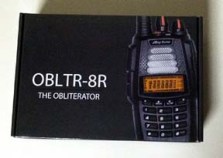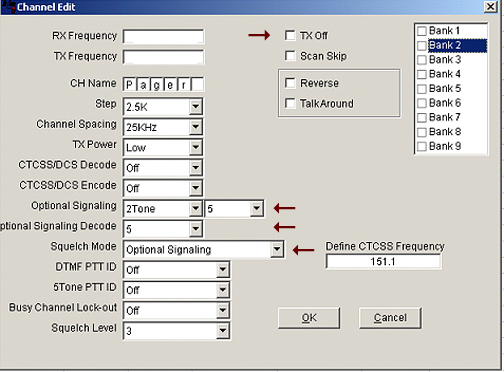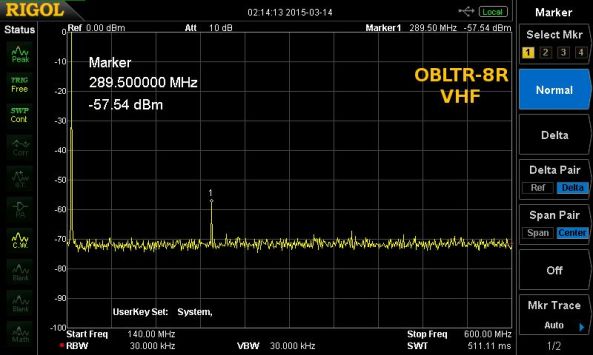by John ‘Miklor’ K3NXU and Hans PD0AC
 I now get a chance to review the OBLTR-8R which is a slightly scaled down version of the TERMN-8R which is the top of the new 8R series offered by Anytone. The only outward difference between the two models is the absence of the orange keys on the left. Once again, when you get one in hand, it becomes very obvious that these radios are were not meant to be competition for the lower end brands, but more of a match for the Wouxun and existing Anytone radios.
I now get a chance to review the OBLTR-8R which is a slightly scaled down version of the TERMN-8R which is the top of the new 8R series offered by Anytone. The only outward difference between the two models is the absence of the orange keys on the left. Once again, when you get one in hand, it becomes very obvious that these radios are were not meant to be competition for the lower end brands, but more of a match for the Wouxun and existing Anytone radios.
This radio is FCC Part 90 certified (Commercial) applications, as well as Part 95A GMRS and 95J MURS services. For GMRS and MURS, the frequencies and power levels hard coded in the firmware. Anyone with dual licenses may now only need to carry a single radio.
What’s in the BOX
There you’ll find the radio, a nicely written and illustrated 104 page English manual, belt clip, wrist strap, Earpiece/Microphone, 7.25 inch (18cm) flexible antenna and hefty 2200mAh 7.4V battery with charger.

The side of the battery has a small charging jack for the optional 12V mobile charger is available for on the road charging.
First Impressions
The overall weight and feel of the radio is solid. The top of the radio has both a Volume/PowerOn switch and Channel Selector knob. The left side has the PTT button and well as two programmable function buttons. The right side has a 2 pin ‘K2’ Kenwood, Anytone, Wouxun, Baofeng style connector. Programming cables and Spkr/Micr for these radios will be totally compatible.
My prior Anytones have somewhat of a concave keypad, where the OBLTR-8R keypad buttons are level and easier to access. Also, the keypad numbers and definitions are illuminated making manual programming a bit easier.
Transmitter
The OBLTR-8R, like its big brother the TERMN-8R, also has 3 power levels that can be changed from the keypad. In the GMRS and MURS mode, the power levels are fixed, per certification requirements. Audio level and quality reports were excellent.
Receiver
The OBLTR-8R has a single Dual Watch receiver that covers
VHF – 136-174 MHz UHF – 400-520 MHz
FM Broadcast – 64-108 MHz (with 100 memory channels)
It incorporates Fast Scan with a scan rate of approximately 10 channels per second.
Some measurements
Power Levels on the test unit were as follows:
VHF – 5.6W, 1.9W, 0.9W
UHF – 4.75W, 2.3W, 1.2W
GMRS – 4.25W
MURS – 1.8W
Sensitivity
Sensitivity VHF (@ 145 MHz): -126 dBm (@ 50Ω, 12 dB SINAD).
Sensitivity UHF (@ 435 MHz): -125 dBm (@ 50Ω, 12 dB SINAD).
Harmonics
Good numbers: -57.54 dBm on VHF, -54.74 dBm on UHF.
When in the Dual Watch mode, the receiver continuously samples the main and sub-band for activity. To eliminate adjacent channel interference, the radio’s receiver reverts to true Narrowband when selected. A full 1W of audio makes the receive quality both loud and clear.
GMRS and MURS operation (FCC part 95A / 95J certified)
Like its big brother, the OBLTR-8R can be switched to operate on any of three modes. GMRS, MURS or Commercial/Normal. To eliminate the possibility of being on the wrong band, a Key Press at PowerOn selects either GMRS or MURS mode. Channel frequencies are hard coded in the firmware as well as their power levels, but allow for CTCSS/DCS tones can be added/changed via the keypad.
Commercial Application (FCC Part 90 certified)
For Commercial, Fire, EMS and EmComm use, the OBLTR-8R is fully certificated with 2.5kHz steps, and software which prevents Field Programming.
NOAA Weather Alert
The seven US NOAA weather alert frequencies are preprogrammed into the radio. There are 3 options to choose from. ON, OFF and ALERT. When WX Alert is chosen, the NOAA weather channel remains silent in the background until the 1050Hz emergency tone signal is received. This is especially useful in areas where severe weather conditions are prominent.
Dual PTT Capability / Programmable Function Keys
There are two PF keys below the PTT switch. Either can be programmed to function as a sub-channel (lower display) PTT button, while the PTT switch activates the upper channel.
The PF keys can also be used to select your choice of:
– Battery Voltage display
– Frequency display
– Tone Calling (DTMF/5TONE/2TONE)
– FHSS (Frequency Hopping)
– Tone Pulse (1750, 1450, 1000 or 2100Hz)
– Alarm Button
– Dual PTT
– MONI (Squelch off)
Channel Banks
The radio supports 200 channels and 10 memory banks. Scanning Group 0 will scan all programmed channels entered into the transceiver. Banks 1 > 9 can be assigned up to 32 channels each.
I found a nice added feature that isn’t on my 3318UV-A. If I want to remove a channel from a particular bank, I can dial in the channel, press two keys, turn the knob and it’s gone. Eliminates the need to me to use the computer to delete the bad ones.
2TONE Sequential Paging
This is extremely useful for the EMS user. I personally have used 2 tone pagers in the past. I can now monitor local EMS channels with one radio.
 Detailed instructions on how to set up the 2-tone and 5-tone paging system can be found HERE.
Detailed instructions on how to set up the 2-tone and 5-tone paging system can be found HERE.
Software
The OEM software is relatively easy to follow, and with a little practice, easy to navigate. Some areas may be a bit tricky, and I’ll try to address those area in the Miklor FAQ section. CHIRP developers are aware of the new Anytone 8R series, but it takes time to backward engineer a radios software.
As always, it is recommended to get a quality programming cable so you spend more time talking on the radio and less time loading special drivers to your PC. I personally use an FTDI cable that is Plug ‘n Play with no driver issues.
Upgradeable Firmware
The OBLTR-8R has Upgradeable Firmware. If features are added in the future, your radio is not obsolete. The firmware can be updated (re-flashed) by an authorized dealer so you will always be able to have the latest version available to you.
IMHO
The developers of the Anytone OBLTR-8R packed a lot of features in a small package. The inclusion of:
– Certified GMRS, MURS and Commercial in one radio
– Upgradeable Firmware
– 200 channels/10 Banks
– Dual PTT
– 2TONE / 5TONE / MSK Messaging
– Stun / Kill capability
at a price tag under $100 level is pretty darned impressive.
Comparison
There are four models in the 8R series. At the top is the TERMN-8R, followed by the OBLTR-8R, NSTIG-8R, and the ANILE-8R. Confusing? Here’s a hint. They are alphabetical. That’s the only way I can keep them straight.
For a comparison between the OBLTR-8R and the others in the 8R series, you can follow this LINK
Price: $98.89 USD (Amazon)
More Information: Anytone Tech, Miklor.com


Nice review and very useful comparison. Thanks, both of you.
None of these appear to have empty battery cases or dc convertors available.
In 2 years when the battery is on it’s last legs you’ll own a brick, not a radio.
Not only are multiple accessories available but so is full support all at: anytonetech.com
Yes, both the high capacity battery pack and DC converters are available.
They are on the accessories page of the ATech website.
Granted about the spare batteries / dc convertor, thanks.
But no empty battery case ?
Still makes a HANDHELD a brick in a year or two, since battery packs are never
available long term and don’t last forever even under no use / storage.
It’s not just these handhelds. but many others too that have inherent obsolescence
because of this.
At least with the Wouxuns / UV5’s etc you can pick up an empty battery case for
peanuts for all of them.
>> …Still makes a HANDHELD a brick in a year or two, since battery packs are never
available long term … Hate to irritate, but packs for the now 11-year-old classic Yaesu FT-60 handheld are plentiful from not only Yaesu, but other respected sources. I am not sure we will be able say that about some of these “gems” we are getting recently ten years from now.
Aren’t you a little bit impatient? When the UV-5R came out there were less accessories available (can’t remember any actually) than with these Anytones. If a battery case comes available, I sure hope it will accept AA batteries, not AAA. The latter can’t even power my Baofeng during TX due to the way-to-low capacity.
With the advances in battery technology, I wouldn’t be surprised to see some new sizes added to the list. Most common today are AA, AAA, C and D. (some B in Europe), I don’t believe A cells are even manufactured anymore.
With the advances in LiPo technology and mAh capacity, I’m waiting for the first ‘spare battery’ pack to use not AA or AAA. but flat LiPo with 4000-5000mAh.
The future isn’t that far away.
I achieve the same performance as having a 400mAH battery pack with my meager 1400mAH ones: Simply improve the antenna, and turn power down to 50% of whatever “high” is. Here in Southern California, if one cannot “hit” a repeater, for example, with 2W and a 17″ quality antenna, then you probably are not going to make it with 4-5W. You’ve all heard me say I regularly work stations several hundreds of miles away with 2W and a little handheld beam … satellites, of course. But try improving your antenna first and lowering your TX power. Make sure you are not over-expecting performance from a VHF/UHF handheld radio.
TYPO – I mean to say, “I achieve the same performance as having a 4000mAH battery pack .. ” – and not, obviously, “400mAH.” Sorry.
My comment was based on Hans’ thoughts regarding a AAA battery not having enough mAh capacity for long life. That’s where a 4000mAh ‘spare’ battery would be nice.
I agree with you totally. I like the extra dB gain coming from the antenna, rather than
the RF.
Impatient…hmmm well I’d rather not take the risk.
There’s no guarantee that such an accessory would be available, so I’d rather see
them before buying.
But before anyone thinks I’m being a bit negative here, I’ll balance it by saying that
the handhelds do have great potential, and if I didn’t have so many already then
I’d be tempted (assuming a cell case was available).
Pingback: This Spewed Out of the Internet #30 - The KØNR Radio Site
I am currently taking classes for my technician’s license and have been following this site as well as miklor.com for some time. I thank you both for the work you put in and providing invaluable resources.
One metric I can’t seem to understand is the Harmonics/Suppression. I understand the basic principles of harmonics, 2nd, 3rd, etc..But having a hard time relating that to the charts and the dB measurements. Is there a resource that you can point me to that explains this in some detail? I tried a few searches and didn’t come up with anything that seemed related to this particular application.
Any help you can provide would be greatly appreciated.
You can’t just pump in 5 Watts into a spectrum analyzer; you would literally blow up the electronics. The damage level of my analyzer for example is 100 mW. Even that amount of power can’t be used, because 100 mW would overload the mixer. This in turn would affect the linearity and you would start to see peaks in the spectrum that aren’t really there.
That’s why you need to attenuate the signal before measuring. For easy comparison I tune the external attenuation in such a way that the reference level is 0 dBm (zero Decibel-milliwatts). Let’s assume that a harmonic measures −3 dBm (heavens forbid), it will correspond to a power of around 0.5 mW. If the source would be a 5 Watt transmitter, it would spit out 2.5 Watts on that harmonic frequency.
This might be helpful: http://cp.literature.agilent.com/litweb/pdf/5952-0292.pdf
Thank You. Your explanation definitely helps me wrap my mind around it. Great pdf as well. Much appreciated.
Who thinks these names up?
I’m thinking it was the CRE-8R of the design.
GROAN!
😀
Only 200 memory channels? Why can’t these manufacturers put more memory channels into their radios? It would be very simple to make them 1000 channels with little to no extra cost. Most users have more than 200 channels they want to put into memory.
Is the TERMN-8R available without the ugly orange side keys/buttons or can it be?
Has anyone read the LAST page of the Anytone manual ?
Click to access OBLTR-TERMN_manual.pdf
Oh dear !!!
Thanks for review. I read on Amazon that MSK is only on the TERMN-8R…not true? I find myself leaning towards the OBLTR as it seems to have all the “real” features of the TERMN-8R. But MSK sounds potentially very useful. Does anybody know, is it practical to use regularly to send ultra short text messages to a second unit, or is it more of a unit ID thing for groups? Can MSK legally be done on MURS? With significantly more range than audio?
If the OB has it, — that may seal the deal!
The OBLTR-8R does not support MSK encoding.
If you set up two TERMN-8Rs on the Same Group – Messaging is as quick as hitting the Function Key+ the PF2 key to get to the message entry – and then as long as it takes to compose + hit the PTT to send
Thank you Anytone!. Any idea if you can do that on MURs? (I assume gmrs not) I’m getting my tech ticket, but my wife likely not. I’m wondering if it can serve as a good backup for a quick message when copying audio is just out of range.